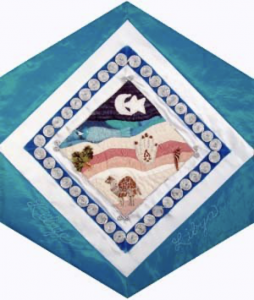Libya

The Block
Samira Elmasri was inspired by the powerful elements of the Libyan landscape, the desert and the sea, and the connection between the nature of the land and the nature of the people. She has used the colours and textures of her favourite natural silks to enhance the design: fluid shades of blue for the sea, layered silk organza to represent the many gradations of the night sky, and silk taffeta––its texture reflecting the shape and movement of the sand dunes. Imposed on the background are the moon and a star, both important directional guides for sea and desert travellers. The block maker has also incorporated a hweta (fish), khmesa (hand), and graine (horn). These symbols represent a well-known Libyan proverb, “Nature and mankind pray for the Prophet’s soul,” which is believed to ward off the evil eye and bad luck. Images of a camel and palm tree (the most prominent features of the desert landscape) are reminders of the strong elements of life in the Sahara. The background fabric, outlined by embroidered ribbon, is a remnant from the wedding dress of the Samira’s daughter. The style of embroidery is typical of designs found on traditional garments worn for special occasions.
Cultural Profile
Libya, a North African nation rich in archaeological sites and one of the least inhabited countries in the world, has been part of the Roman, Byzantine, Arab and Ottoman empires over the centuries. Historically, during the period when conditions were better for agriculture, it was known as the ‘granary of the Roman Empire’ (along with Tunisia). Today, with over 90 percent of the nation covered by the Sahara desert, farming is only possible along the Mediterranean coastal strip. The only permanently flowing river is the two-kilometres long Wadi Ki’am; all other rivers called wadis, only carry water for a few months during the rainy season. Libya’s main ethnic groups are Arab, Berber and Tuaregs. The remainder of the population is comprised of a mixture of other races. The official language is Arabic, although Italian and English are widely understood in the major cities. Once mostly nomadic, Libyans are now overwhelmingly urban, a shift caused by the discovery of oil in the country. However, the family remains as the foundation of Libyan life, with kinship and lineage still having a major impact on a person’s choices in life. Music and dance play an important part in Libya’s strong tradition of folk culture. Folk dances performed at the country’s frequent festivals are accompanied by Libyan music. Common instruments such as ouds (similar to a lute or Spanish guitar), darbukas (type of drum), zukras (similar to bagpipes), flutes and tambourines are combined with complicated hand-clapping to create a varied texture of sounds. Libyans have well-earned reputations for their kindness and hospitality, characteristics enjoyed by visitors to the popular souks (outdoor marketplaces) found in all Libyan cities. From the small shops that line the narrow lanes of the souks, farmers bring their produce to market; merchants sell spices, traditional clothing featuring colourful stripes and handmade carpets. Skilled craftsmen sell their handmade gold and silver jewelry, copper and silver dishes, leather goods, baskets and pottery. Libyans have been coming to Canada since the late 1940s with the most significant numbers arriving between 1946 and 1975. Many left their homeland for social and economic reasons, or because of civil unrest, while others left to further their education abroad. A 2011 census indicates that there are around 5,500 Libyans now living in Canada.
Sponsor: Georgina and Roy Yorke, dedicated to peace
